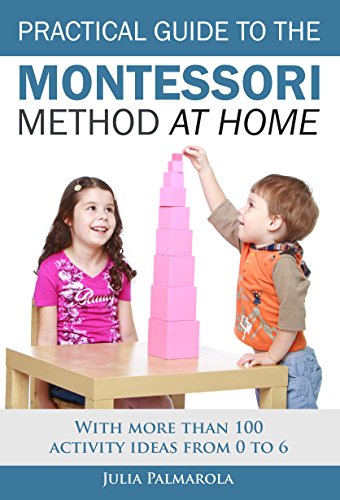Today, we’re going to be talking about you being The Montessori Guide, what that means and what you can expect to take on as your responsibilities.
Which of the following statements accurately describes your knowledge of what it means to be a Montessori Guide?
- A Montessori Guide is a book you read with information about the philosophy
- The Montessori Guide is a binder full of lesson plans to follow
- A Montessori Guide is the adult in The Montessori environment
Correct answer: C
What is the difference between this in a Montessori school or homeschool and a traditional school teacher?
Let’s Go Deeper
Come learn about some of the most important and distinguishing characteristics of this wonderful job in this awesome method of education.
This is the place for you, if you are looking to become a centered and organized Montessori Guide.
Read on to learn how to nurture happy and normalized children and create smooth and successful Montessori days.
In the comments section, please tell me what you know about this topic.
I’ll respond to everyone individually.
On this day, we’re going to talk about you being The Montessori Guide.
Let’s talk about what that means and what kind of duties you can expect to be assigned.

Watch & Listen to the Episode Here:
As you watch or listen to this training, know that you will be able to get more information than what is included in this blog post.
However, I really want to encourage you to take the time to watch or listen and take notes.
Importantly, this will be helpful to you now and in the future.

#1 What is the Montessori Guide?
Allow me to highlight a few of the most important high quality characteristics that a Montessori Guide should possess.
When compared to other professions such as teachers, why do we refer to ourselves as “guides”?
We are not teachers in the traditional sense, at least not in the context of the Montessori Method.
Our role is to connect children with their environment, specifically with their Montessori environment.
We do this through observing their interests and responding to them according to their precious Sensitive Periods.
Also, we prepare the environment. We allow the children to serve as their own teachers, with the older children serving as mentors to the younger ones.
Maria Montessori, the founder of the Montessori philosophy, is credited with saying that if she were looking for a guide, she would prefer to find someone who was not a teacher.
To be more specific, Maria Montessori was looking for someone who did not come to teaching with any preconceived notions about what it meant to be a “teacher.”
This is due to the fact that traditional education (public schools) appears very different from Montessori learning.

Two Things
The Montessori Guide begins by doing two things: observing and following.
What does this mean, particularly in the context of homeschooling or doing Montessori at home?
You might be curious about what it’s like to live a day in the life of a Montessori Guide.
As children work in the environment with their Sensitive Periods chart and notes in hand, the Guide will sit back and observe what they are doing and what they are learning.
Even if she is implementing Montessori in the home, she will determine where each child is.
Then she’ll take all of the information she’s gathered and go after the child to find out what happened.
This means that she will create a Montessori environment that is specifically designed to target those open Sensitive Periods.
She will also allow the child to unleash all of his or her learning potential through curiosity, self-motivation, and the natural flow of his or her interests.
You should always remember that the teacher education rule #1 is to Observe and Follow.
#2 You are the mastermind behind it all
It seems like there are new misconceptions about Montessori education being propagated on a daily basis. It makes me wish that I could dispel them with the snap of a finger.
The reality is that it is not as simple as it appears, so I will start with the fundamentals.
One of the most common misconceptions about Montessori education is that children are left to their own devices in order to educate themselves.
Even though some of it is true, it is not the whole truth. As a result, it tends to give people the wrong impression.
The most important truth to take away from this is that the Montessori Method seeks to instill a sense of wonder in young children about learning.
Furthermore, as older children develop a strong enough passion for learning, to serve as role models for their younger counterparts, the awe grows and grows.

Attention
However, the most important truth to take away from all of this is that, even though the emphasis is on the child, the Montessori Guide is the mastermind behind the scenes of the program.
He or she is the one who lubricates the wheels, arranges the activities in accordance with Montessori principles, observes and follows the child, and is the spark that ignites the child’s enthusiasm for learning.
Montessori Guides play a critical role in the Montessori environment because they are instrumental, essential, and fundamental to the process.
The importance of you in the Montessori classroom cannot be overstated, especially in the early years.
Montessori materials and the Montessori Curriculum 3-6 are only a small part of the picture.
You will be involved in the lives of children in a variety of ways, not just in academic subjects.
You will also be imparting life skills and character traits to your students.
Your goal today is to recognize and appreciate yourself for who you are, and to recognize that you are important brains in your wonderful Montessori adventure.
#3 You give guidance
“But when…work is the result of an inner, instinctive impulse…it assumes a wholly different character. Such work is fascinating, irresistible, and it raises man above deviations and inner conflicts.
Such is the work of the inventor or discoverer, the heroic efforts of the explorer, or the compositions of the artist, that is to say, the work of men gifted with such an extraordinary power as to enable them to rediscover the instinct of their species in the patterns of their own individuality.”
Maria Montessori, the Secret of Childhood
It is, in no way, suggesting that the Guide in the Montessori environment does not take an active part in the education of the child.
Quite the opposite, actually, especially if you are looking at creating a Montessori daily schedule that runs smoothly as you are doing Your Montessori teaching.

The Guide’s Role
Her role in the environment is essential because so much of the success in it hinges on her centering herself before serving the children.
Not because she works in the background instead of the foreground that her work is not important or life-changing.
Instead of providing answers to children or doing things for them, the Montessori Guide will patiently ask children to device ideas on how they would solve the problem, actively involving children in the thinking and learning process to enhance critical thinking skills.
This one small thing, while it requires a lot of time and patience, will do so much for them, not only in the immediate future, but for the rest of their lives.
And you know what?
As you practice this more and more in your Montessori environment, you will notice that in most cases, the children you work with will actually learn directly from the environment and from other children, rather than you.
Is your mind blow yet?
What a concept, right?!
In Conclusion
HERE ARE THE RESOURCES MENTIONED IN THIS EPISODE:
Like I said at the beginning of the show, I have a FB group for all things Montessori that you are welcome to join.
It is called The Montessori Way Prep Room.
If you want to join a homeschool Facebook community, then join The Natural Homeschool Community!
Resources and Books for Montessori Teachers:
These Montessori books are from the author of The Montessori Philosophy.
But some are also Montessori inspired by great authors, such as Paula Polk Lillard.
Do you need one-on-one Montessori training?
Consider the coaching option, too!
The Montessori Method The Secret of Childhood
The Secret of Childhood The Absorbent Mind
The Absorbent Mind The Discovery of the Child
The Discovery of the Child Montessori from the Start: The Child at Home, from Birth
Montessori from the Start: The Child at Home, from Birth Practical Guide to the Montessori Method at Home: With more
Practical Guide to the Montessori Method at Home: With more
- Motor Skills for Hands the Montessori Way
 The Montessori Method puts a special focus on developing motor skills for hands, recognizing how essential they are for independence, confidence, and curiosity.
The Montessori Method puts a special focus on developing motor skills for hands, recognizing how essential they are for independence, confidence, and curiosity. - Simplify Toy Rotation with Montessori Checklist
 Make Toy Rotation Simple and Fun with the Montessori Toy Rotation Checklist Labels and Chart. Organizing your child’s play area shouldn’t be stressful! That’s why the Montessori Toy Rotation Checklist, Labels & Chart is every parent’s new best friend when it comes to keeping toys fresh and shelves inviting.
Make Toy Rotation Simple and Fun with the Montessori Toy Rotation Checklist Labels and Chart. Organizing your child’s play area shouldn’t be stressful! That’s why the Montessori Toy Rotation Checklist, Labels & Chart is every parent’s new best friend when it comes to keeping toys fresh and shelves inviting. - Sight Words for Toddlers in Montessori Language Arts
 When you look into Montessori Language Arts, you will find a unique and engaging approach that helps toddlers master these important words.
When you look into Montessori Language Arts, you will find a unique and engaging approach that helps toddlers master these important words. - Sensitive Periods in Child Development
 These sensitive periods are unique windows of opportunity that help children easily absorb important skills and concepts.
These sensitive periods are unique windows of opportunity that help children easily absorb important skills and concepts. - Montessori Practical Life Step 1 Guide
 Montessori Practical Life Step 1 Checklists The Easy Way to Keep Your Montessori Journey Organized: Discover an affordable, printable checklist set that helps you organize lessons, track progress, and ensure Practical Life success for every child.
Montessori Practical Life Step 1 Checklists The Easy Way to Keep Your Montessori Journey Organized: Discover an affordable, printable checklist set that helps you organize lessons, track progress, and ensure Practical Life success for every child. - How to Incorporate Montessori Activities into Your Baby’s Daily Routine
 Well, let me get started by telling you that it isn’t just incorporating it into your baby’s daily routine… you need to make it a part of your own as well!
Well, let me get started by telling you that it isn’t just incorporating it into your baby’s daily routine… you need to make it a part of your own as well!
















Leave a Reply